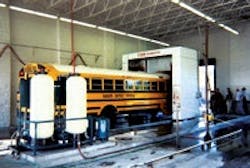About the author: Steve Prior is president of Waste Water Management Inc. Prior can be reached at [email protected] or 561.747.8028.
The school board of Sarasota County, Fla., was faced with a challenge common to many organizations: The growth of its operations was outstripping the capacity of one of its facilities. In particular, its bus-washing capabilities were unable to keep up with increasing number of school buses that needed to be washed every day. Although its maintenance building included two wash bays, its traditional hand-washing process was time-consuming and labor-intensive.
After researching its options, the district decided to install an automated bus-wash system in one of the bays and an automated rinse system in the other. The automated bays and higher volume of buses created a new problem: a dramatic increase in water usage. With no sanitary sewer system available, all of the water would need to be recycled and treated for reuse as both wash- and rinse-quality water.
Water Treatment & Recycling System
In the fall of 2001, the school district selected Waste Water Management Inc. (WWMI) of Jupiter, Fla., to design and install the overall water treatment and recycling system for the bus facility. The task involved integrating the existing underground storage tank system into a water treatment and recycling system that would produce high-quality water but occupy a small footprint located in the center of the washing process. WWMI’s engineering staff identified a number of initial factors that needed to be addressed in the design criteria:
- • The quality of the recycled water needed to be as close to potable as possible to be acceptable for the entire automated washing operation, with a portion of that water further treated to rinse quality for the automated rinse.
- • The location of the equipment in the center of the washing bay area required the design and utilization of components that could operate under constant exposure to water and chemicals being sprayed in the bays.
- • The narrow area available for the equipment pad dictated the layout of the recycling system to permit ready access to the underground tanks and serviceability of the recycling equipment.
- • With no sanitary sewer available, the system needed to be capable of treating and recycling 100% of the water while taking into account filter backwashing, membrane reject water, and water losses from evaporation and drive-off. System balance was critical to preventing the accumulation of excess water in the system that would require excessive hauling from the site.
The WWMI design team studied the bus traffic flow patterns and daily washing and rinsing requirements in order to develop an equipment configuration that met all the design criteria. Jim Woodson, facilities manager for the facility at the time, provided detailed engineering plans showing the underground tank orientation and interconnecting plumbing lines. He also provided on overview of the facility’s growth rate to ensure the equipment design could handle the projected increases in bus traffic.
The quality of water required for the automated washing and rinsing equipment dictated the use of multiple levels of water filtration. The underground tanks were re-piped to make them more effective as both a preliminary solids settling area and an oil-water separation system. The water then was pulled through a large-volume mixed-bed multimedia filter to reduce the suspended solids level to below 40 μ in size. Water polishing then took place in a granular activated carbon (GAC) column to remove most of the organics and odors in the water. Both filters were managed by the system’s main programmable logic controller-based control system, with automated valves for filter backwashing and differential pressure sensors. Final water polishing occurred in cartridge-type filters prior to delivery to the automated wash equipment. A large ozone generator was incorporated to provide disinfection of the treated water and to eliminate odors.
The water for the automated bus rinse arch was treated through an additional GAC filter and 5-μ cartridge filter, then processed through a membrane system to remove substantially all of the cleaning agents. This stored rinse-quality water then was delivered to the automated rinse arch on demand.
All of the equipment was mounted on stainless steel frames, and all possible components were either specified in stainless steel or non-ferrous to minimize corrosive failures in the wet environment. NEMA-4X enclosures, totally enclosed fan-cooled motors and epoxy- or powder-coated components also were routinely used to improve equipment longevity. The entire water treatment and recycling system, with the exception of the rinse water components, was designed to fit on the 4-by-8-ft equipment pad in the center of the wash building, between the manhole covers for the underground tanks.
Balancing Water Usage
Balancing the system’s water usage was one of the more challenging parts of the project. Because all filter backwashing and membrane reject water remained in the system, the WWMI design team knew that eventually the total dissolved solids of the recycled water would become too high for acceptable rinsing and would need to be removed from the site. The team modified the rinse system to provide a lower volume of water at higher pressure to reduce the demand on the membrane system. Benefits of the facility’s geographic location included the constant warm breezes and high rate of both drive-off and evaporation losses. This significantly extended the life of the recycled water, and for the past 12 years, the site has been able to schedule only one tank pump-out annually to maintain high-quality recycled water.
Since the system’s installation in the winter of 2001, WWMI has provided quarterly preventive maintenance and routine equipment upgrades, and the system is projected to continue to operate successfully well into the future.
Download: Here
